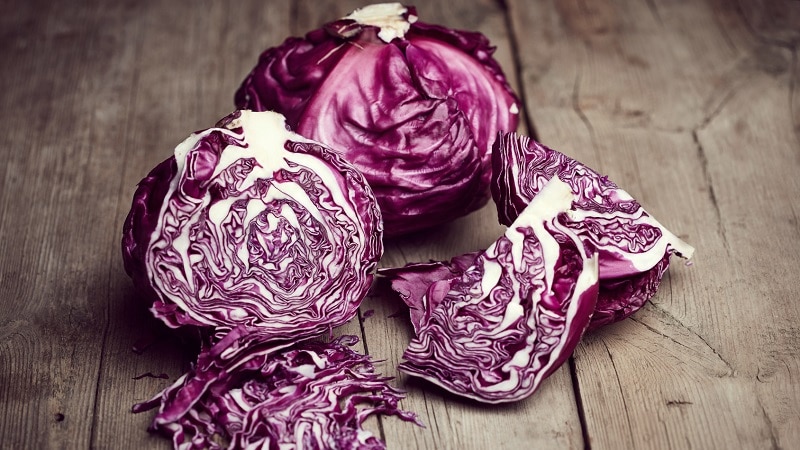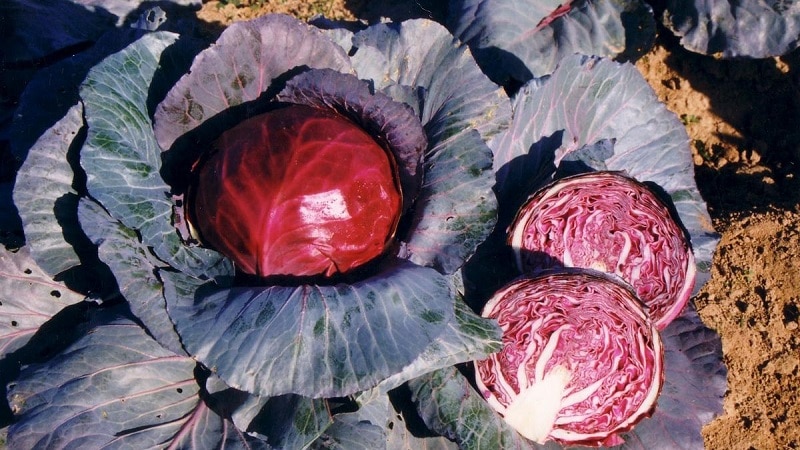Red cabbage: description and cultivation features
Red cabbage is a close relative of white cabbage, but in dietary and taste qualities it is superior to it. In Russia, red cabbage is not very common due to the nuances of cultivation and the late ripening of most varieties. However, more and more gardeners are growing this crop.
Description of red cabbage
Botanically, red cabbage is almost identical to white cabbage.. It appeared in the CIS countries back in the 18th century. Brought from the Mediterranean. Especially popular in Algeria, Tunisia, Greece and Turkey.
This is a two-year culture. In the first year it bears fruit, and in the second year it begins to form brown and round seeds that ripen in pods. The powerful root system passes into the stalk - the root stem, on which the head of cabbage and surrounding leaves are formed.
Depending on the variety, the weight of the vegetable ranges from 1 to 4 kg. The shape is most often round or flattened, in some varieties it is dome-shaped.

The stem is very short, so the heads of cabbage are close to the ground. The root system is sufficiently developed and powerful for the plant to tolerate dry seasons normally and almost never go into decline.
The leaves have little juice, making them poorly suited for pickling. The color of dishes with cabbage becomes specific, and most of the nutrients are lost. The vegetable is perfect for salads.
What is purple cabbage called?
Blue, red and purple cabbage are names of the same crop. Even botanists cannot answer why it is considered red. However, the name stuck and has been used for many decades.
Why is she purple?
The unusual color of the vegetable is due to the content of natural pigments - anthocyanins.. The hue ranges from red-violet and blue-lilac to purple.
Reference. The color of the leaves is also affected by the type of soil in which the crop is grown: in alkaline soil the vegetable becomes bluer, and in acidic soil it turns red.
Anthocyanins give cabbage not only its unusual color, but also its bitter taste., which not everyone likes. However, most modern hybrids do not have this drawback.
What is the difference between red and white cabbage?
Red cabbage tolerates frost much better than white cabbage. She gets sick much less often and is attacked by insects. Forms very dense heads of cabbage.
The most suitable temperature for vegetable development - +16...+18°C, but plants can tolerate frost down to -8°C.
Red cabbage takes longer to develop than white cabbage. The heads of cabbage are smaller, but they are quite dense. They contain 4 times more carotene and 2 times more vitamin C. Anthocyanins strengthen the cardiovascular system.
The leaves of the crop are drier, so cabbage is rarely used for pickling or preparing first courses, such as borscht.
Growing red cabbage
The culture is not very capricious, but it is important to choose the right time for planting before winter and prepare the bed in advance.
Planting before winter
For planting before winter use late-ripening cabbage varieties. It is advisable to increase their number by 2 times compared to spring planting. Some of the seeds will freeze over the winter in any case, so in the fall they are planted more densely so that there are no empty spaces in the garden after germination.
Sown after the arrival of a steady cold spell. The soil in the garden bed should be covered with a crust. It is important to carefully monitor the weather forecast so as not to plant seeds before a thaw.
The bed is prepared in advance, before the arrival of frost.. It is advisable that the site be near a fence or some kind of building. This will protect the plants from strong winds. The place must be lit.
While digging the beds, phosphorus-potassium fertilizers and organic matter are added. Add 1 bucket of humus or compost per 1 m². Phosphorus-potassium fertilizers are applied in accordance with the instructions on the package.
After fertilizers and digging immediately make furrows for planting, the bed is covered with polyethylene. After the arrival of frost, it will be much more difficult to make furrows.
Dry seeds are used for planting. They must be large and of high quality.
Care
The first shoots appear soon after the snow melts. Due to the instability of the weather, there is a possibility of repeated frosts. To protect the seedlings, the bed is covered with film or non-woven material, which is stretched over wire arches.
After stable warm weather has established, the shelter is removed. The ground under the seedlings is mulched with sawdust, hay or pine needles.
If necessary, thin out the sprouts. Mature plants should be located at a distance of about 40 cm from each other.
Water the cabbage once every 5–10 days, depending on the weather.. Each plant requires 5–7 liters of water.

When to Harvest Red Cabbage from the Garden in the Fall
Red cabbage is harvested a few days after the onset of light frosts. (down to -2°C). Then it will be more tasty and the shelf life will increase.
Important! The weather should be dry during harvest.If it starts to rain, the heads of cabbage are cut and put into an unheated room for drying.
For each fork, leave 2-3 covering sheets. After some time, they will dry out and form a protective layer that will prevent moisture evaporation.
The minimum length of the stalk should be 3 cm, because it cracks during storage. If the stalk is short, the cracks will go deep into the head of cabbage, and it will begin to rot.
How to store for the winter
The best temperature for storing crops is -1…+3°C. Suitable humidity is 95–98%. If the temperature is higher, the heads of cabbage will gradually begin to rot, and if the humidity is low, they will dry out.
Store red cabbage in the cellar, on the loggia or in the refrigerator. For long-term storage, it is better to send it to the cellar. Here, vegetables are hung from the ceiling, covered with sand, placed on racks, and the roots are deepened into a moist substrate.
Hanging from the ceiling greatly saves usable space. For such storage, the stalk should be as long as possible. A rope is tied on it, and the vegetable is hung upside down. Thanks to the covering leaves, condensation will not get on the heads of cabbage, so the cabbage is not afraid of thaws.
If the heads of cabbage are dug up with roots, they are usually immersed in a moist substrate. Sand or a sand-earth mixture is poured into the boxes and kept moist. The roots are buried in this substrate.
Without roots, cabbage is placed in boxes and covered with dry sand.. It is important that individual heads of cabbage do not touch each other.
If the forks are small, it is better to store them in a clay shell. The clay is mixed in water to obtain the consistency of thick sour cream. The heads of cabbage are dipped in mash and dried in the open air. Then they are sent to the cellar.
Thick paper is often used instead of clay.. Each vegetable is wrapped in it. Replace paper that becomes wet during storage.
Reference. In the cellar, cabbage remains usable until spring.
When storing on a loggia, make a small elevation from boards or put thick foam. Place cabbage on top at small intervals, cover it with boards or polystyrene foam and lay out the next layer of vegetables. The heads of cabbage are not wrapped in anything.
It is important to constantly monitor the temperature on the loggia. If it drops below -1°C, the cabbage is insulated, for example, with a blanket. When the temperature rises, the shelter is removed.
Due to temperature changes, condensation often forms. To prevent the heads of cabbage from starting to rot, they are inspected regularly. Damaged leaves are removed. During storage The cabbage is placed with the stalk down. It is important that the heads of cabbage do not touch.
In the refrigerator, the harvest remains fresh for up to 2 months. It is placed in a bag or wrapped in cling film and sent to the vegetable department. Each head of cabbage is stored in a separate bag.
Conclusion
Red cabbage is a healthy and tasty vegetable that is suitable for fresh consumption. The culture is resistant to frost, pests and diseases. It's easy to grow. The main thing is to choose the right time for planting, prepare the bed and water the plants regularly.